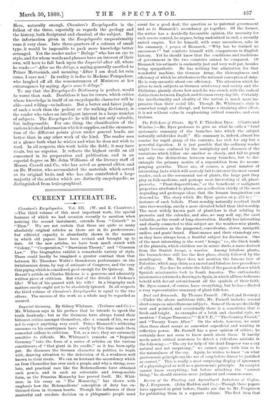The Folk-Lore of Plants. By T. F. Thiselton Dyer. (Chatto
and Windus.)—Mr. Dyer professes to give us what he calls a "brief systematic summary of the branches into which the subject naturally subdivides itself." His summary is, indeed, almost too concise for rapid grasp of the contents, too rich for any but a powerful digestion. It is just possible that the ordinary reader might become confused by the mutiplicity and closeness of the variations which follow one another so closely, and fail to grasp not only the distinctions between many branches, but to dis- entangle the primary motive of a superstition from its accom- panying growths. There are, of course, a great number of interesting facts which will scarcely fail to interest the most casual reader, such as the ceremonial use of plants, the large part they play in folk-medicine, and perhaps most interesting of all, plant- proverbs. " Plant-Superstitions," or the beneficent or malignant properties attributed to plants, are a collection chiefly of the most degrading and grotesque ideas that the human imagination can descend to. The story which Mr. Dyer quotes on p. 273 is r instance of such beliefs. Plant-worship naturally resolved itself into tree-worship, surely a more elevated belief than idol-worship. The most widely known part of plant-lore is that relating to proverbs and the calendar, and also, we may well say, the most valuable, as the result of long observation. Hardly less interesting and closely connected to this subject are the weather-wise plants, such favourites as the pimpernel, convolvulus, clover, marigold, endive, and goats'-beard. Plant-names and their etymology are, as they have always been, a fruitful subject for discussion. One of the most interesting is the word " kemps," i.e., the black heads of the plantain, which children use in mimic duels, a name derived from the Danish kcenipe, a warrior. Among fabulous plants, the barnacle-tree still has the first place, closely followed by the mandragora. Mr. Dyer does not mention the famous tree of Palestine, which may claim as a sacred and fabulous tree precedence of either. Nor does he relate the fable of the passion-flower which Spanish missionaries took to South America. The enthusiastic missionaries returned a drawing to Spain, in which all true believers beheld with devout astonishment all the symbols of their faith. Mr. Dyer cannot, of course, have everything, but he has collected a very representative summary of plant folk-lore.


















































 Previous page
Previous page